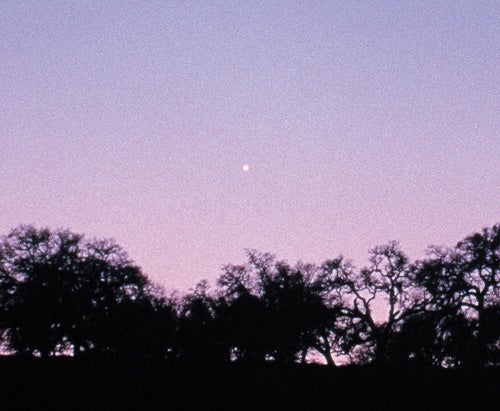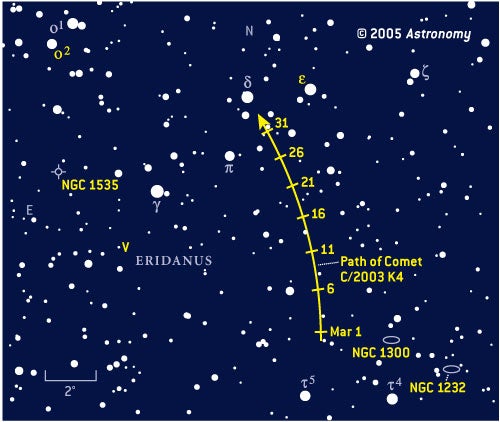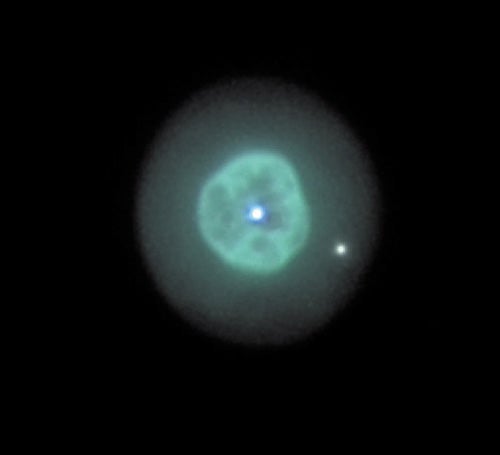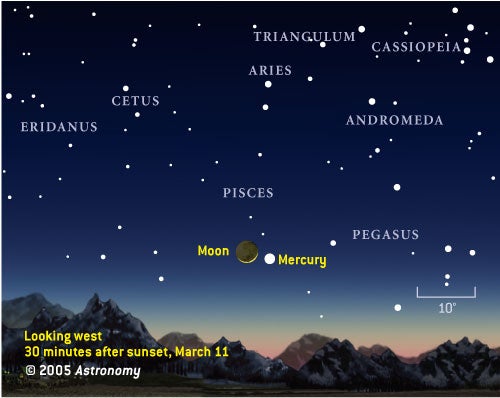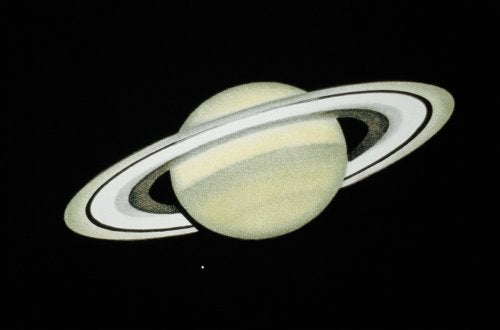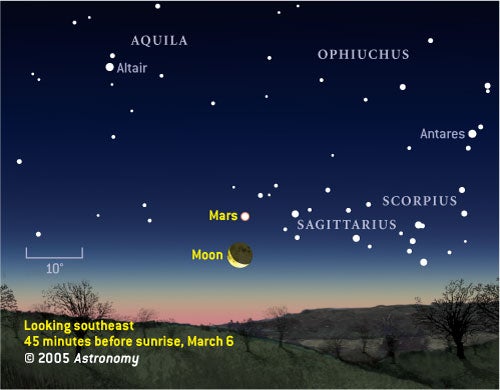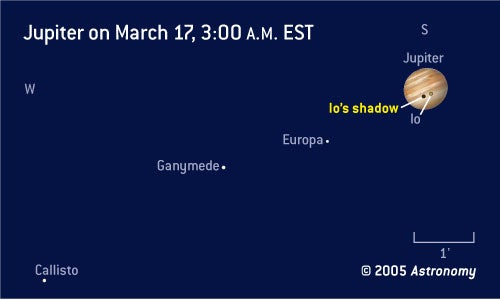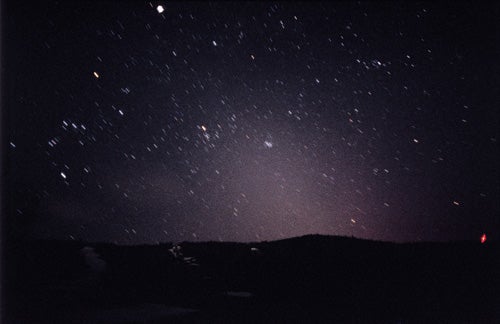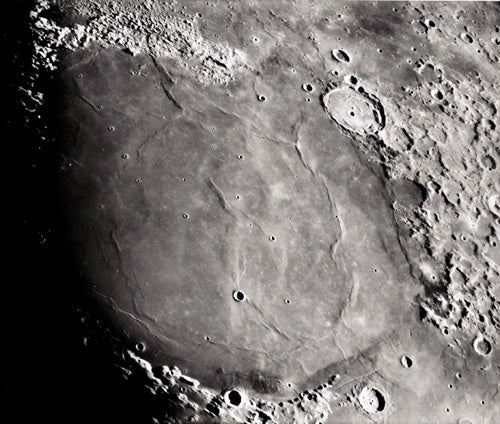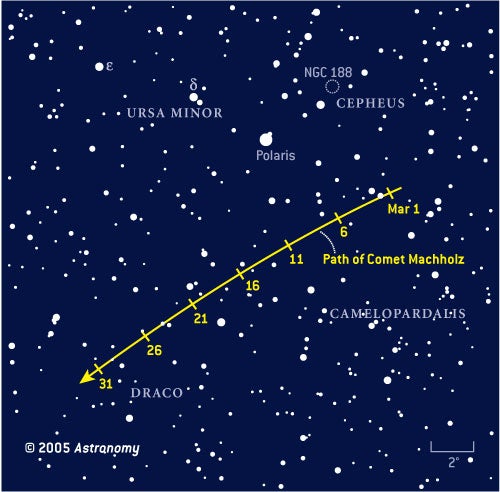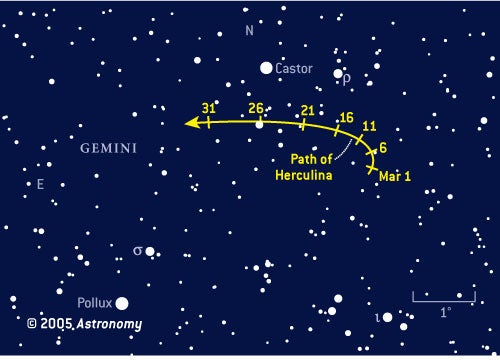During the third week of March, Mercury fades as it takes on more of a crescent shape, a result of it starting to swing between Earth and the Sun. You can follow its quickly changing phase during the clear stretches of weather that tend to occur this time of year.
Saturn’s steady yellow light rides high and bright in the south on March evenings. Well away from the thick atmosphere near the horizon, the ringed planet has a good chance of being free of the earthly turbulence that washes away finer details. Take a long look — note the color differences between the inner and outer rings, and look for the black gap, the Cassini Division, that separates the two.
Speaking of Cassini, the robotic explorer of the same name takes its second close look at the icy moon Enceladus March 9. This world, one of the most reflective bodies in the solar system, showed an intriguing array of geological features to the Voyager spacecraft in the early 1980s.
The sparkling winter stars are a sight to behold as darkness falls. Ruddy Aldebaran and Betelgeuse float high, while blue-white Rigel and brilliant Sirius twinkle below. The winter sky appears even more impressive from a dark site, well away from the choking glow of city lights. As you become more dark-adapted, the sky continues to fill with stars to the point where many beginners have a hard time picking out the constellations. Anchor yourself with Orion and its “belt” in the south, and with the Big Dipper standing on its handle in the northeast, and you will find your way to other constellations.
A special sight (but not for city-bound observers) comes into view in the west after the last vestiges of twilight have disappeared. The zodiacal light appears as a pyramid-shape glow, with its base along the western horizon and its rounded tip arching to the left of the Pleiades star cluster. Tiny dust particles that permeate the inner solar system reflect sunlight and cause the zodiacal light.
Comets contribute some of the meteoric dust in the solar system. A modestly bright comet visible this month is C/2004 Q2 (Machholz), now positioned near Polaris. The comet’s roundish coma and tail are made from dust and gas ejected from its nucleus. Is your sky dark enough for you to spot it without optical aid?
If you happen to be observing under a dark sky with members of an astronomy club, chances are you’ll hear about the Messier marathon. At this time of year, all of the deep-sky objects — dazzling star clusters, distant galaxies, and fuzzy gas clouds — in the Messier catalog can be seen in one long night from dusk to dawn. Such a marathon is more a test of your star-hopping and map-reading talent than your observing skills, but it can be a fun way to spend a spring night.
The longest constellation pattern in the sky, Eridanus the River stretches from the foot of Orion south to Tucana and Hydrus, well below the horizon for most Northern Hemisphere observers. (Although Hydra covers more territory, the River meanders back and forth so much, its pattern is longer.) One of the River’s stars, Epsilon (ε) Eridani, has become fairly famous for being one of the closest Sun-like stars easily visible to the naked eye. The only closer stars brighter than Epsilon Eri are Sirius and Alpha Centauri — and blazing Sirius is far from Sun-like.
In 1988, Bruce Campbell of the Dominion Astrophysical Observatory in Victoria, British Columbia, first reported Epsilon has a planet. Recent studies indicate the planet has about 90 percent of Jupiter’s mass and orbits its star where our main-belt asteroids lie around the Sun. Unfortunately, there are two strikes against a habitable earthlike planet in this system. First, the Jupiter-like planet has a modestly eccentric orbit, which would likely scatter any smaller worlds. Second, the star seems quite active, throwing out violent flares that likely would prevent a planet in an earthlike orbit from developing a stable climate.
To locate Epsilon, use the circular star map in the center of the magazine, and look for a point forming an equilateral triangle to the southwest of Rigel and Aldebaran. Through the eyepiece, Epsilon appears as a pale yellow-peach dot. Until we get a closer look with more advanced telescopes, our imaginations alone will have to take us to this nearby outpost.
Back toward Rigel lies Omicron2 (ο2) Eri. This system harbors the easiest-to-see white dwarf in the sky, one visible through even a small telescope. At low power, a wide pair greets the eye. The fainter of the two, which glows at magnitude 9.5, is the white dwarf. Such a star has passed through its red-giant phase and blown off its outer layers, leaving a hot core of helium and carbon “ash” to cool slowly over the eons.
Interestingly, the white dwarf has a slightly fainter companion that orbits it in about 250 years. Push up the power past 120x, and look about 7″ (twice the separation of summer’s Double Double) to the northwest. This pair currently shows its widest separation, and a small scope should barely split it.
The nebula NGC 1535 is the remains of a star just heading into its white-dwarf phase. Ultraviolet light from the hot core causes the star’s puffed-off shell to fluoresce, creating a shining gas cloud called a planetary nebula. The deep-sky observers who discovered these objects were reminded of ghostly versions of the outer planets, hence their seemingly inappropriate designation.
Under a dark sky, a 3-inch telescope at low power will reveal an out-of-focus “star.” Even from the city, an 8-inch scope can pull in enough light from the nebula’s 18″-diameter disk to give it a pale blue sheen. Bigger scopes add more detail and an elongated shell surrounding the central star.
For a pleasing color contrast, have a peek at V Eridani, a yellow-orange variable star that lies 4° to the southwest.
Crossing the River
Now fading past 9th magnitude, Comet C/2003 K4 (LINEAR) glides slowly across the sky south of Epsilon Eridani. Compare the comet’s diffuse shape with that of the nearby face-on spiral galaxies NGC 1300 and NGC 1232. Although the field of view will darken as you increase the magnification, it’s the only way your eye can pick out the subtle differences in the structures of these three objects.
Before darkness settles in, Mercury makes its best evening appearance of the year. On March 1, Mercury shines at magnitude –1.4 and stands 6° above the western horizon 30 minutes after sunset. The innermost planet lies in Pisces, but the dim stars of that constellation won’t be visible against the bright sky. While Mercury climbs higher each passing day, it also fades a little. By the time it reaches greatest elongation from the Sun March 12, the planet shines at magnitude –0.4. Still, it won’t be hard to see because it then lies 11° high half an hour after sunset.
Probably the best evening to view Mercury is March 11, when a 2-day-old crescent Moon lies nearby. You can spy Mercury 4° (eight Moon-widths) to the Moon’s lower right. A view of Mercury through a telescope that evening reveals the planet’s 7.2″-diameter disk, which appears 48-percent lit.
In the days following its greatest elongation, Mercury remains fairly high but fades rapidly. It reaches magnitude 0.3 March 17, when it lies 10° above the western horizon 30 minutes after sunset and sets 1 hour later.
As the sky darkens and Mercury sets, Saturn waits for attention nearly overhead. While dramatic discoveries continue to pour in from the Cassini spacecraft, beautiful Saturn appears no less dramatic through a backyard telescope. Saturn lies due south around 9 p.m. local time March 1, and about an hour earlier every 2 weeks after. The planet lies in Gemini the Twins, near the pair of bright stars Castor and Pollux.
For observers at mid-northern latitudes, Saturn comes within 15° of the zenith at its highest. High altitude is good — you’ll be viewing Saturn through the least amount of Earth’s turbulent atmosphere possible. This improves the chances of getting steady images that provide the finest detail on the planet. Although Saturn’s location makes it a clear target for evening observation, the high altitude almost demands a star diagonal, which diverts the image 90°, on your scope for comfortable viewing. Otherwise, the nightly contortions of your neck required to view an object almost straight up will remind you, later the next day, that you should have invested in this handy device.
Observers can get an extra thrill by identifying Saturn’s larger moons through a telescope — especially this year, when Cassini will image many of them in unprecedented detail. Titan, the largest moon, shines at magnitude 8.3 and proves an easy target in any scope. You can find it due north of Saturn March 3 and 19 and due south March 11 and 27. Saturn’s 10th-magnitude moons — Tethys, Dione, and Rhea — show up nicely in a 4- to 6-inch scope.
Enigmatic Iapetus had some of its surface revealed by Cassini late last year. The moon’s dramatic dichotomy, with one bright and one dark hemisphere, causes an effect that can be viewed through small scopes from Earth. During March, Iapetus lies east of Saturn but begins to travel westward and brighten slowly. The strange moon varies in brightness by nearly two magnitudes, appearing brighter at its western elongation — a situation that occurs in late April. Iapetus glows at 11th magnitude this month.
Jupiter gleams at magnitude –2.4 in March, making it the brightest point of light in the sky. It lies between two bright stars in the constellation Virgo — Spica (Alpha [α] Virginis) and Porrima (Gamma [γ] Vir, a nice double star), but neither star rivals Jupiter. The planet’s retrograde motion this month carries it closer to Porrima. You can find Jupiter 10 Moon-widths to the lower left of the Full Moon March 25.
Jupiter lies 420 million miles from Earth in mid-March, when it appears 44″ across through a telescope. The planet reaches the pinnacle of its current apparition in early April, when it shines brightest, appears largest, and lies opposite the Sun in our sky.
Telescopic views of Jupiter can be wonderful. The most prominent features are two dark belts that straddle the equator. Subtle shadings make up the remainder of the atmospheric features that skid around the planet at breakneck speed. Just remember the planet you are viewing is 11 times Earth’s diameter but rotates in less than 10 hours. As a result, in just 10 to 15 minutes, you can detect quite easily the motion of features across the disk. Occasionally, you’ll see the salmon-pink Great Red Spot on the Earth-facing hemisphere.
Often, one of Jupiter’s four bright moons will cast its shadow on the planet’s face. For example, Io’s shadow crosses Jupiter’s disk on St. Patrick’s Day, March 17. Start watching Jupiter at 1:39 a.m. EST, when the shadow begins its transit. Io moves quickly, and the shadow scoots across the disk in 2 hours and 12 minutes. The shadows of the more distant moons move slower. You can see for yourself the night of March 6/7, when Ganymede’s shadow traverses Jupiter’s disk. The action begins at 1:51 a.m. EST and lasts nearly 3 hours, concluding at 4:32 a.m.
Mars rises around 4 a.m. local time March 1 and lies 10° above the southeastern horizon an hour before sunrise. The relative position of the Sun and Mars changes little during the month. Meanwhile, Earth’s orbital motion causes the background constellations to drift behind Mars. In early March, we see Mars against western Sagittarius. By the 20th, Capricornus has slid into our line of sight toward Mars. On the 24th, the Red Planet lies 6° south of Beta (β) Capricorni. Mars remains a tiny object, barely 5″ across, when viewed through a telescope. Better views will be seen later this year.
An attractive conjunction of the Moon and Mars occurs March 6. Set your alarm for around 5 a.m. to catch Mars 6° above a slender crescent Moon. Mars shines at magnitude 1.1, just about the same as Antares, the brightest star in Scorpius. The star now lies some 40° west of Mars. Note the two objects’ similar color.
Because the star emits its own light and Mars merely reflects sunlight, their matching color is nothing more than a coincidence. Antares shines a subtle shade of orange because its surface temperature — about 4,400° Fahrenheit — makes it glow rather like a red-hot poker left in a fire. Mars, on the other hand, glows reddish because rusty soil gives reflected sunlight that color.
Streams of meteors come and go throughout the year, but March tends to be quiet. Sure, there’s a small shower, barely detectable, that emanates from Virgo. But there’s more than one way to view the dust in our solar system. The easiest is to see the streak of light created as a dust particle plummets to its fiery demise in our atmosphere. Yet before any of these particles strike the air above us, they wander the solar system as meteoroids.
is to see the streak of light created as a dust particle plummets to its fiery demise in our atmosphere. Yet before any of these particles strike the air above us, they wander the solar system as meteoroids.
Meteoroids — the name given to solid dust particles — are the debris deposited by innumerable comets and created as asteroids grind against each other. The particles reach their highest density along the ecliptic, the plane of the solar system defined by Earth’s orbit. Sunlight shines on these particles and, if conditions are just right, observers on Earth can see the glow. Because the glow follows the ecliptic, which the zodiacal constellations encompass, it is known as the zodiacal light.
March provides the right conditions. This month, the ecliptic makes a steep angle to the western horizon after sunset from northern latitudes. Once the twilight glow has disappeared from the sky, about 90 minutes after sunset, scan above the western horizon for a faint cone of light that extends past the Pleiades. To see the light, you will need clear, dry air and absolute darkness to the west — even an intervening streetlight or glow of a distant town will render it invisible. In the high desert of the southwestern United States, the zodiacal light can be seen almost every clear, moonless night. The subtle glow is sunlight reflecting off billions of fine dust particles — these are the pride of March’s meteoroids.
Near the border between the Moon’s Mare Tranquillitatis and Mare Serenitatis lies the 17-mile-wide crater Menelaus. This crater inhabits the rough-edged southern shore of Mare Serenitatis. It appears well-defined, which indicates a relatively young age, and contains a couple of central mountains on its floor. The crater walls rise nearly 2 miles above the surroundings and are finely terraced.
A mountain range extends eastward from Menelaus toward a larger crater, Plinius, which is some 27 miles wide. The range juts out into the flat mare floor at a point called Promontorium Archerusia, just short of Plinius. Intricate rilles crisscross the surrounding plains. You can catch sunrise over Menelaus 2 days before First Quarter Moon, or March 15 this month. Initially, the crater rim will catch the sunlight, but with each passing day, you’ll see the crater walls and floor become illuminated. As Full Moon approaches, the crater becomes a brilliant white ring with asymmetric rays.
Glowing brightly at 6th magnitude, Comet C/2004 Q2 (Machholz) should show up nicely in binoculars as it swings over Earth’s pole on the outbound leg of its journey through the inner solar system. Observers watching from under a dark sky may be able to spy a slightly fuzzy dot with their naked eyes.
Comet Machholz should have a noticeable tail some 1° to 2° long. Comet tails always point away from the Sun, which means Machholz’s tail should be angled roughly toward the bowl of the Big Dipper. A comet’s tail forms from gas and dust liberated from its nucleus by the Sun’s heat. The gas gets ionized by solar ultraviolet light and then carried away from the Sun by the solar wind. The dust is pushed away from the Sun by the gentle pressure of sunlight.
Fork-mounted telescopes like the popular Schmidt-Cassegrain models have a weakness when pointed toward the celestial pole because the eyepiece ends up in an inconvenient location. If you’re not planning to do photography or precise go-to observing, consider misaligning your scope 90° to the pole. That way, you can swing the eyepiece into a more comfortable position. Because the comet lies so close to the pole, you’ll find the field drifts lazily, which is easy to handle with slow-motion controls.
While you’re in the vicinity, check out NGC 188, one of the oldest open star clusters known. It has survived so long because it rarely passes through the high-density regions of the galactic plane. At low power, you’ll see dozens of faint stars freckling the background sky.
Comet C/2003 K4 (LINEAR) remains with us in the evening sky, but it is fading rapidly as it moves away from both the Sun and Earth. It currently lies in Eridanus, to the west of Orion, and is plotted on page 57.
If you’re running an all-night Messier marathon, don’t forget to check out Comet C/2003 T4 (LINEAR) in the morning sky. It lies approximately halfway between the bright globular cluster M15 and the Milky Way.
Some asteroids are easier to find than others — it all depends on the available signposts. The double star Castor, the northern one of Gemini’s two brightest stars, points the way to 532 Herculina. This asteroid glows modestly at 10th magnitude, so you should be able to spot it through a small scope from a city backyard. Herculina measures 130 miles across, similar in size to Saturn’s moon Phoebe, which the Cassini spacecraft revealed in detail a few months ago. You can watch Herculina approach a pair of 10th-magnitude stars March 21 and share the field with a gleaming 5th-magnitude star the 26th and 27th.
Just southwest of Pollux lies another asteroid, 8 Flora. And next month, we’ll highlight 2 Pallas, a bright main-belt asteroid, as it slides through galaxy country in Virgo.

